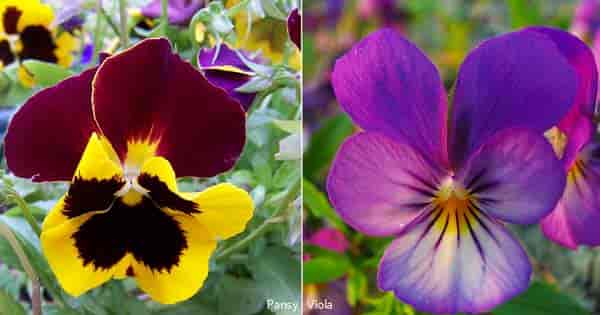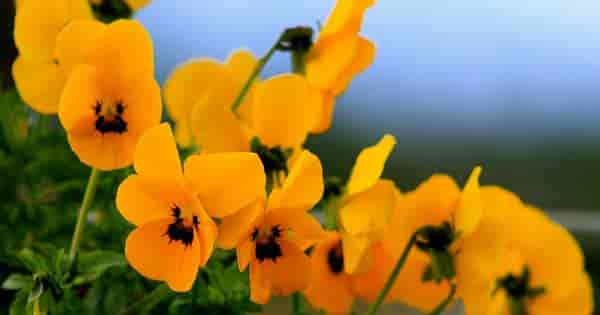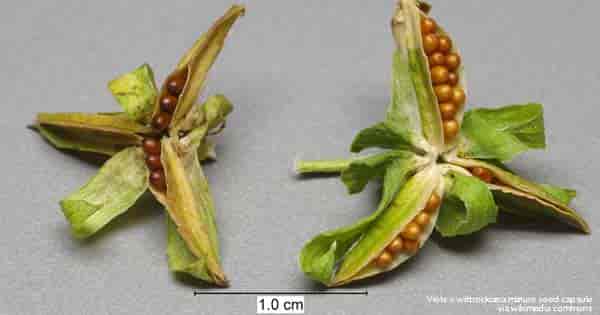Pansies are popular, easy-to-grow flowers that provide early color in cold climates and winter blooms in milder climates.
Pansy plants make wonderful cool weather additions to the garden. Their bright colors put a smile on a cold, dreary, winter day.
The pansies we are familiar with today have come from many years of hybridizing and crossing with violas, their small, wild ancestors.
In this article, we discuss pansies and violas and share information to help you choose, care for and even cook with these delightful flowers. Read on to learn more.
Pansies Provide Welcome Color In Winter And Early Spring
These cheery little plants display their colors just when they are most needed.
At the end of winter, count on well-established pansies to lift your spirits and herald the coming of spring.
How Long Do Pansies Bloom For And Do They Bloom All Summer?
With the right setting and proper care, pansies will continue flowering throughout springtime and well into summer. They begin to fade when temperatures rise.
Although they are often mistaken for annuals, many gardeners count on pansies to fill flower beds with bright blooms in preparation for summer flowers every spring.
Do Pansies Come Back Year After Year?
Pansies if planted and sheltered properly will return and bloom year after year.
What Is The Difference Between Pansies And Violas?
 Pansy Flower via Wikimedia | Viola Flower via WikimediaThe much larger flowers of today’s modern pansy hybrids are very different from their modest ancestors. These showy flowers are available in shades of white, blue, violet, red and yellow.
Pansy Flower via Wikimedia | Viola Flower via WikimediaThe much larger flowers of today’s modern pansy hybrids are very different from their modest ancestors. These showy flowers are available in shades of white, blue, violet, red and yellow.
Very often, these larger flowers have a dark “face.” “This was first discovered on a sport (mutation) in the late 1830s,” when “pansies were first becoming popular in Europe and England.” [source]
Pansy hybrids bloom in the early spring and provide winter color in mild climates.
Their ancestors are the smaller “bedding violas.” They are also available in many colors, but they do not have a dark face.
Violas do not bloom in winter and/or early in the springtime. Instead, they bloom primarily in summer and prefer cooler summer temperatures.
Pansies (Viola × wittrockiana)
These pansy hybrids stand about eight inches tall. Their large flowers range in size from two-to-four inches across. Their dark green oval or elliptical leaves are about an inch long.
This popular hybrid provides a confetti-burst of color in the early springtime with blossoms in yellow, apricot, rose, red, maroon, purple, blue and a wide variety of white bi-colors.
Lifespan: Hybrid pansies are herbaceous perennials and often grown as annuals.
Season: Enjoy their blooms from late winter into the early summer months, typically April through June.
Natural Habitat: Pansies are entirely domesticated and grow mostly in gardens; although, they will naturalize under ideal conditions. [source]
Hardiness: USDA zones 6-10.
Height & Spread: Hybrids grow to be between 6-9″ high and can spread 9″ to one foot.
Light Requirements: In cooler climates, pansies like full sun. In hot climates, they prefer part shade.
How Often and How Much Water and Fertilizer Do Pansies Need? A thorough weekly watering is usually sufficient.
Check to be sure the soil never dries out completely. Provide a light feeding (half-strength water-soluble fertilizer) every two weeks throughout the spring and summer months.
Soil Requirements: These agreeable plants will do well in almost any well-draining, fertile potting or bedding mix. Well-draining, humus-rich soil should be kept consistently moist.
Do You Deadhead Pansies? What Maintenance Do They Need? Deadhead and pinch back wilted leaves throughout the blooming season. Cut back leggy, straggly plants to rejuvenate them. Mulch as needed in cold climates.
Blossoms: Showy, colorful, fragrant.
Growth Habits: The plants grow quickly and spread rapidly at first but later grow more upright. In areas with hot temperatures, pansies tend to become lanky and pale.
Attracts: Deer like the protein-rich plants. The flowers Hummingbirds like, they also attract butterflies and other pollinators. The plants may also attract rabbits!
 Yellow Pansy flowers via wikimedia | CC 2.0
Yellow Pansy flowers via wikimedia | CC 2.0
How To You Keep Pansies From Getting Leggy, Looking Full and Flowering All Season
Pansies do better in cooler weather. During warm weather, they get leggy, don’t produce flowers, usually don’t look good.
Tips On Revitalizing Pansies
- Look for insect damage from earwings or other insects (we like Neem for control)
- Keep pansies constantly moist. They don’t want to be soggy or dry out completely
- When they dry out they tend to begin to seed
- Deadhead – remove all faded and spent flowers, this helps the plant to produce more blooms and branch out
- Remove the whole stem for appearance only
- Stems pinch easily with well-watered plants and new buds form quickly
- At end of the season allow some of the seed pods to ripen and collect them for next season
Should You Buy Seedlings Or Grow From Seed?
In early spring, it’s easy and affordable to buy flats of pansies in garden centers.
If you live in a very cold area, purchasing these pansy plants and putting them out in the garden after all danger of frost passes may be your best bet.
 Viola × wittrockiana mature seed capsule via Wikimedia commonsIn warmer climates, try growing your pansies from seed. Here are two easy methods.
Viola × wittrockiana mature seed capsule via Wikimedia commonsIn warmer climates, try growing your pansies from seed. Here are two easy methods.
1. Sow Indoors In Winter
Planting pansies with this method gets faster germination but later blooms.
You can sow pansy seeds indoors in the winter during January and February. Prepare a seed tray with a good seed starter mix.
Sprinkle the seeds lightly over the mix and cover them with a very thin layer of sand. I use “builders sand.”
Keep the seed tray slightly damp throughout the germination period. Your seeds should start to grow within a couple of weeks.
When you see new growth, set the seed tray in a cool, shaded, protected area. Continue with light watering.
When your seedlings develop a second set of leaves, remove the seedlings from the tray and put them into small, individual peat pots.
Keep them in a still, well-lit, cool setting. Water regularly.
After the seedlings develop several sets of leaves, begin “hardening” them off by allowing them a little time outdoors on clear, warm, windless days.
When all danger of frost passes and your plants have had the chance to acclimate to the outdoors, plant them in your garden or put them into pots or containers for your balcony, porch or patio.
More in our article: Growing Pansies From Seed
2. Sow Indoors In Summer
This method gives plants more of a chance to grow strong and resilient, but you’ll have to wait several months for blossoms.
The process is very similar to sowing indoors in winter, but you would start in June, July or August.
If you live in an area with a mild climate, you can plant your young seedlings out into your garden in September.
If you live in a very cold area, keep your seedlings indoors through the winter or plant them out and mulch them with straw or something similar to protect them from the cold.
How To Use Pansies In The Garden
Versatile pansy plants are great for edging, bedding, planters, adding color to window boxes and dress up strawberry jars.
They make excellent companions for most plants and are especially suited as a “cover crop” for spring bulbs.
Pansies can be planted over bulbs. They will appear and begin blooming early in the spring.
When the weather and the soil warm up, your tulips and daffodils will burst through.
This makes a very nice display of taller spring and summer flowers surrounded by a carpet of pansies.
In containers gardens, plant pansies about six inches apart. They will soon fill out to make a pretty display in your window box, balcony box or any container.
Pansy Culture
Although pansies can naturalize, reseed themselves and return year after year.
Most gardeners prefer to remove them from the garden when they begin look straggly when the heat increases during the hot summer months.
This is why pansies are usually grown as annuals (planted and enjoyed in a single spring and summer) or as biennials (planted in the fall and enjoyed the following spring and summer).
In the southern United States, pansies are very popular because they bloom throughout the winter and into the spring.
If your winters are mild, you may not need to mulch your biennial pansies.
Generally speaking, small, but well-established plants fare better through the winter months than larger ones.
When choosing to plant pansies in the autumn, they will bloom very early in the spring.
If you choose to set them out in the spring, you must wait until after all danger of frost has passed.

Do Pansies Have Problems With Pests And Diseases?
Overall, pansies are very easy to grow and do not face any serious maladies or insect attacks.
Leaf Fungus Disease
Like all plants, they are subject to problems with fungus if they are kept too wet for extended periods of time.
If fungal leaf disease develops, you may notice dark, brownish, semi-transparent spots on the leaves.
You can treat this (in container plants) by isolating the affected plants, trimming away the affected areas and applying a fungicide or spraying with a Neem oil solution.
Keep the quarantined plants in a setting with good air circulation and do not water until the soil in the pots becomes almost dry.
You may need to repot the plants into fresh only slightly damp soil.
If this problem affects bedding plants, you should pull up the affected plants and dispose of them.
Use a fungicide on the remaining plants and alter your watering habits to prevent more fungal growth.
Trim out excess and/or dead leaves to eliminate crowding and improve air circulation.
Crown Rot
Crown Rot is a very serious fungus problem that cannot be treated in individual plants because this soil fungus kills plants from the roots up.
By the time you notice it, your plant is already dead.
If your pansies are attacked by Crown Rot, you can only remove them, dispose of them and replace the soil they were in entirely.
Before putting new soil in place, treat the area with a fungicidal soil drench designed to treat for soil fungi.
Powdery Mildew
Powdery Mildew is another fungal problem. This occurs when the weather is damp, humid and cool.
If you notice a light dusting of white over the leaves of your plants, you probably have powdery mildew.
Use a fungicidal spray specifically formulated for use against powdery mildew.
Slugs and Snails
Slugs and snails may eat your pansies. See our article 9 All Natural Ways To Get Rid Of Slugs In Your Garden.
Cutworms
Cutworms feed at night cutting off the plants just at the ground line, and, will destroy pansy plantings during the early spring cool, moist weather.
They burrow into the ground just below the soil surface during the day.
When night time and darkness arrives they exit to begin feeding again. Check plants shortly after the sun rises before the cutworms have had time to feed and burrow back underground.
What Are Viola Plants?
The term “viola” is actually correctly applied to about 500 different kinds of annual bedding plants and wildflowers, but the plant we wish to discuss here is the ancestor of the hybrid pansy.
Violas are quite a bit like pansies, but the flowers are smaller and the growth habits are different.
Traditional violas (Viola odorata) have flowers no larger than an inch and a half across. Pansies typically have flowers two or more inches across.
While pansies provide color through the winter and in the early months of spring, violas typically bloom later in the spring and well into the summer.
Heirloom And Hybrid Violas Offer Variety
The violas available today descended from the Sweet Violet (Viola odorata) which is an heirloom perennial.
This pretty little wildflower has dark purple flowers and a very sweet scent.
In a modern garden setting, you will typically find two types of violas.

The first is Johnny Jump Ups (Viola tricolor) also called “Heartsease” which is a self-sowing annual.
This hardy little plant lives only a year, but its offspring “jump up” year after year once a stand is established.
The flowers are tri-colored: purple with white and yellow centers.
The small flowers are no bigger around than a nickel and have dark markings (lines or whiskers) in the light colored centers.
The second type of viola you’ll frequently see in the garden is commonly called the Tufted Pansy or Horned Violet (Viola cornuta).
These little violets come from the Pyrenees mountains and from Spain. They grow wild in these temperate climates and are perennial in most settings.
These hardy plants grow in low mounds that stand between eight and ten inches high.
Viola cornuta’s lightly scented flowers come in a vast array of colors. They are marked with attractive contrasting lines radiating from the blossom center.
There Are Many Attractive Varieties Of Classic Tufted Pansies
- Arkwright Ruby (Amazon) has deep red blooms, golden edged blooms with golden centers.
- Chantreyland (Amazon) has large, attractive apricot colored blossoms.
- Yellow Perfection is a solid shade of yellow.
- Blue Perfection is solid blue.
These heirloom varieties are open-pollinated or naturally pollinated, as opposed to being subject to the controlled pollination techniques used with hybrids.
In addition to these time-honored classics, there are also several newer open-pollinated violas:
- Princess comes in yellow, blue, purple and bicolor combinations.
- Velour (Amazon) comes in three types and twenty different colors.
There are also some hybrid violas. Examples include:
- Penny (Amazon) comes in numerous shades of blue and purple, ranging from very pale to very dark. There are also many attractive choices in shades of red, yellow, orange and white.
- Sorbet is available in over thirty colors ranging from pale pastels to dark shades and two-tone combinations.
Some of the hybrid violas have lines or whiskers like Johnny Jump Ups. Some have darker centers (faces) like hybrid pansies.
All of these are smaller than pansies and grow in attractive mounds in the garden. They flower continuously throughout the growing season.
- Skippy XL Red-Gold (Amazon) is an exception among violas.
This hardy, prize winning hybrid produces flowers that are nearly as large as those of a hybrid pansy.
The blossoms of the first in the “Skippy” series are deep red with purplish-red markings and a golden “face.” Other colors have been (and are being) developed.
Other hybrid viola choices include the very hardy Patiola series that produces flowers as large as pansies but boasts greater durability.
There are also trailing hybrids, such as Erlyn and Splendid that do very well in hanging baskets.
Pansy Plants Buying And Planting Tips
Whether you are purchasing violas or pansies or both, look for compact, healthy looking plants with intact, green leaves.
Don’t buy bedding plants of any kind with yellow leaves as this indicates:
- Nutrition deficiencies
- Root damage
- Disease
- Stress from under or over-watering
When you purchase a stressed plant, it will take longer to establish itself in your garden. In fact, it may never do well.
Don’t purchase excessively root-bound plants where lots of roots are protruding through the drain holes.
- This indicates a plant that has been in its temporary container too long.
- This makes plants difficult to remove from the container without damaging the root system.
When removing bedding plants from their temporary containers, do it gently.
- Loosen the soil by tapping the outside of the container and tipping the plant out into your hand.
- Place the plant in a hole with the surrounding soil at the same level as the soil in the plant’s previous container.
Soil for pansies and violas should be well-draining and rich with compost and organic matter.
When planting mounded violas, give them 6” or 8” inches of space all around.
If you are planting spreading or trailing types into beds, give them more room. Ten or twelve inches should be ample.
If you live in the northern United States, place your plants in a setting with full sun exposure.
If you live in the south, partial shade will be more conducive to success with pansies and viola plants.
Pansies, Violas Or Both?
Just like pansies, violas are good bedding plants, and do great in containers and window boxes, so why not plant both?
A combination of the two ensures lots of interest and color in your garden through winter and spring and well into the summer months.
Trailing violas make wonderful choices for hanging baskets or as an attractive, fragrant ground cover.
Additionally, sweet violas are a tasty treat!
Viola flowers are used as garnish for desserts. They can be tossed in salads. They can be candied or used to make tea, jelly, jam or crepes! [source]
 Pansy Flower via Wikimedia | Viola Flower via Wikimedia
Pansy Flower via Wikimedia | Viola Flower via Wikimedia Yellow Pansy flowers via wikimedia | CC 2.0
Yellow Pansy flowers via wikimedia | CC 2.0 Viola × wittrockiana mature seed capsule via Wikimedia commons
Viola × wittrockiana mature seed capsule via Wikimedia commons
